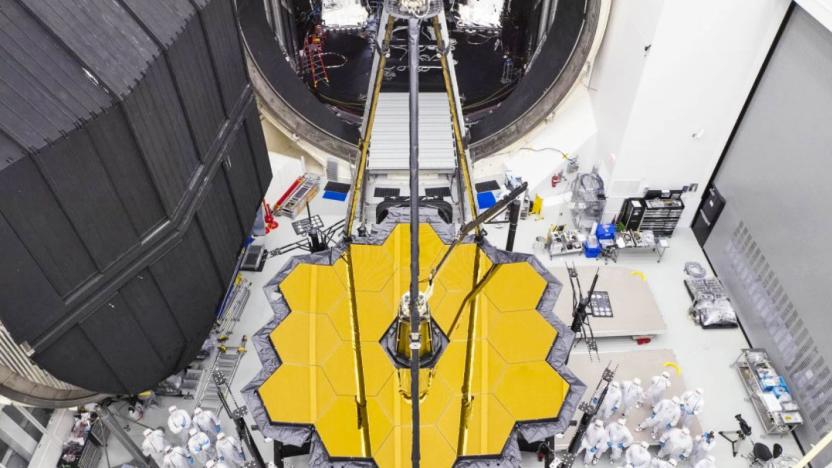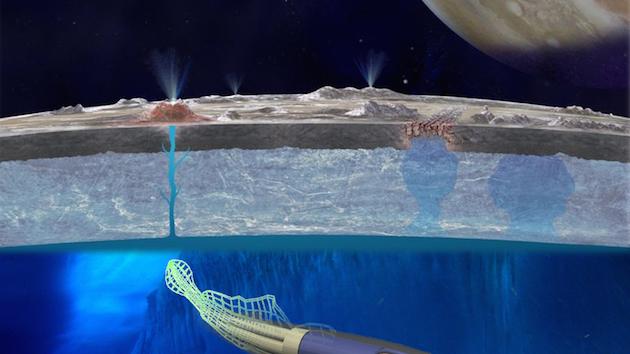cryogenics
Latest

NASA's James Webb telescope is one step closer to launch
NASA's $8.8 billion James Webb Space Telescope (JWST) has just left the thermal vacuum chamber where it's spent more than three months being put through its paces in a series of hardcore cryogenic tests. Scientists wanted to make sure the telescope's instruments and optical element can function properly in the cold, airless conditions of space, and while NASA studies the results, engineers are busy putting JWST back together again, in preparation for its launch in spring 2019.

UK judge grants girl's dying wish to be cryogenically frozen
In what's thought to be the first case of its kind, a UK judge granted a dying girl's last wish to be cryogenically frozen. The 14-year-old was diagnosed with a rare form of cancer last year, but as of this August was switched from active treatment to palliative care. She began researching cryonics and decided to be frozen following her death, but had to take the legal route to ensure her wishes were respected when her estranged father disagreed with what should happen to her body. After several hearings, a High Court judge granted her mother sole responsibility for making arrangements, and the girl now rests in the Cyronics Institute in the US.

Scientists reanimate tiny frozen animals after 30 years
In 1983, the first consumer mobile phones launched and "Star Wars" meant Return of the Jedi. That year, scientists from Japan's National Institute of Polar Research collected microscopic animals called "tardigrades" from Antarctic tundra. They then placed them in a freezer, where they spent the next 30 years. In 2014, researchers decided to defrost the samples to see if the tiny creatures, also called "moss piglets," would come back to life. When the thawing process completed, two creatures started wriggling immediately, setting a new deep-freeze duration record for tartigrades.

NASA thinks a robotic eel might be the key to exploring Europa
We've seen the submarine that NASA wants to explore Saturn's moon Titan with, but compared to what the aeronautics outfit's looking at for icy climes like Jupiter's Europa it's downright pedestrian. The wormy-looking contraption up above is actually considered a type of amphibious rover and it's pretty different from the Deep-SCINI we've seen previously. Because there aren't exactly electrical outlets anywhere aside from Earth and relying on solar power might not always be feasible, it has to use alternative means for energy. In this case, NASA says antenna on the soft robot's back would draw energy from "locally changing magnetic fields."

Scientists take detailed pictures of the smallest known life forms
Just how small can life get? Almost unbelievably small, if you ask a team of Berkeley Lab researchers. They've taken the first detailed electron microscope pictures of the tiniest bacteria known to date -- at a typical 0.009 cubic microns in volume, you could fit 150 of them in an already miniscule e. coli cell. Scientists had to catch the hard-to-spot microbes by using a new portable cryo plunger, which flash-froze groundwater to near absolute zero (about -458F) to keep the cells intact while they were in transit.

Master Chief and his cryotube toy set
Master Chief is getting a cool deluxe figurine set from McFarlane Toys featuring everyone's favorite interstellar peace-keeper in a UNSC cryotube. The set includes a posable Master Chief, the cryotube (complete with realistic frost detail) and a pistol, and will be available in August.McFarlane is also developing figurines of Master Chief, an Elite Zealot, a Storm Grunt, a Spartan Warrior, Cortana, a Spartan Soldier and two new enemies, the Crawler and the Watcher.The cryogenic Master Chief appears to be extremely similar to the initial prototype McFarlane showed off in February, which means we still wonder how he goes about turning his head between Madonna's cast-off shoulder pads. At least his all-essential forearms are protected.

NASA collects proposals for space fueling stations
Sometimes rocket science is actually, you know, rocket science. Getting to the moon was tough enough, but deep space exploration poses all manner of additional concerns -- like getting back home alive, for one thing. And then there's the issue of fuel, something long distance trips require a lot of -- but stocking up on here on Earth means potential weight problems at launch. One proposal offered up in the past is space-based fueling stations conveniently located in key spots on the way to a distant destinations like the Moon, Mars, and asteroids. NASA is collecting proposals that can demonstrate the validity of such a plan, including the ability to store liquid oxygen and hydrogen, transfer it, and have a ship approach for fueling. If you think you've got your bases covered -- and can keep it under $200 million -- you've got until May 31st at 11:59 PM EST to hand over a proposal.

Inhabitat's Week in Green: frozen energy, spray-on solar and the hydrogen peroxide helicopter
Each week our friends at Inhabitat recap the week's most interesting green developments and clean tech news for us -- it's the Week in Green. It was a big week for green transportation as San Francisco broke ground on its massive green-roofed Transbay Transit Center and unveiled plans to install 5,000 EV charging stations throughout the Bay Area. We were also wowed by several fun new forms of alternative transportation - a single-person helicopter that emits nothing but water vapor and a human-powered car that can go 30 MPH while driving uphill! It was also an exciting week for energy storage tech as New York prepared to power up the world's first grid-scale flywheel energy plant and researchers cracked the code on a new cryogenic energy storage system. We also showcased a plan for a ribbon-like solar field that unfurls over the desert and saw researchers unveil a transparent solar spray that can transform practically any surface into a sun-capturing source of energy. In other news, solar tech energized the arena of interior lighting as we showcased an adorable solar-powered table lamp and were dazzled by this set of folding OLED origami lights. Finally, a team of scientists blew our minds with this light-bending invisibility cloak made from gold-coated silk.






